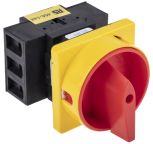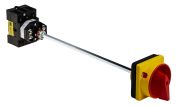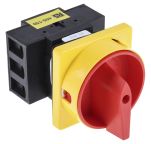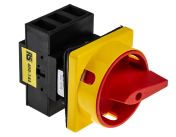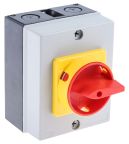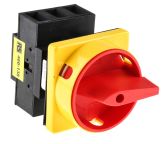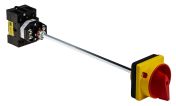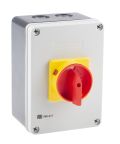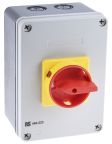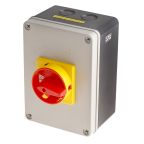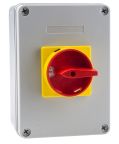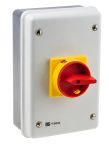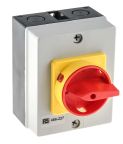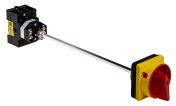Isolator Switches
Isolator switches, also known as disconnect switches or circuit breakers, are electrical devices used to disconnect electrical circuits from their power source. They provide a means of isolating circuits or equipment for maintenance, repair, or safety purposes. Isolator switches are designed to interrupt the flow of electrical current and provide a physical barrier to prevent accidental contact with live electrical parts. They are commonly used in industrial, commercial, and residential settings to ensure the safety of personnel and equipment during maintenance or emergency situations.
How Does an Isolator Switch Work?
An isolator switch operates by disconnecting a portion of an electrical circuit from the main power source, ensuring that maintenance and repairs can be carried out safely. When the isolator switch is in the "off" position, it creates an open circuit, preventing the flow of electricity to the isolated section. This is crucial in various industrial and commercial settings, as it provides a clear visual indication that the circuit is de-energised, enhancing safety. Isolator switches can handle varying maximum current ratings, typically ranging from 20A to 200A.
Isolator switches also come with different IP ratings, such as IP65 or IP66, indicating their ability to withstand dust and water ingress, making them suitable for both indoor and outdoor use. They are available in various mounting types, including panel-mounted, wall-mounted, and DIN rail-mounted configurations, to fit specific installation requirements. Additionally, they can be single-pole, 2-pole, or even 6-pole, providing versatility for different electrical setups.
What are the Benefits of Isolator Switches?
Safety: The primary advantage of isolator switches is enhancing safety. They provide a clear and reliable means of disconnecting power to equipment or circuits, reducing the risk of electric shock or accidents during maintenance or repairs.
Maintenance: Isolator switches allow equipment or circuits to be safely de-energized for maintenance or servicing. This ensures that technicians can work on the equipment without the risk of electric shock or damage.
Emergency Response: In the event of an emergency, isolator switches can quickly and easily disconnect power, preventing further damage or hazards
Energy Management: Isolator switches can be used to control the energy supply to specific areas or equipment.
Fault Identification: Isolator switches often include indicators or visible disconnects, allowing for easy identification of whether a circuit or equipment is energised or de-energised.
Compliance: Isolator switches are frequently required by electrical safety codes and regulations to ensure proper safety measures are in place.
Single or 3-Phase Isolator switch?
Isolator switches are available in both single-phase and three-phase configurations, depending on the specific application and electrical system requirements.
Single-Phase Isolator Switches: These switches are designed for single-phase electrical systems, where power is supplied by a single line and a neutral conductor. They are commonly used in residential and small commercial applications where the electrical load is relatively low.
Three-Phase Isolator Switches: These switches are designed for three-phase electrical systems, where power is supplied by three separate lines and a neutral conductor. Three-phase systems are commonly used in industrial, commercial, and larger residential applications due to their higher power requirements.
**Industrial Applications of Isolator Switches **
**Electrical Distribution Systems **
Isolator switches are used to disconnect sections of an electrical distribution system for maintenance or emergency purposes. For example, a 3-phase isolator switch can isolate transformers and circuit breakers to ensure safety during service.
**Industrial Machinery and Equipment **
Isolator switches ensure the safe maintenance of industrial machinery by disconnecting the power supply. A 4-pole isolator switch can isolate heavy-duty equipment like CNC machines and industrial presses, preventing accidental operation during repairs.
**Renewable Energy Systems **
In renewable energy systems, isolator switches disconnect solar panels or wind turbines from the grid. A solar isolator switch is essential for safely maintaining and servicing solar inverters and arrays.
**HVAC Systems **
Isolator switches in HVAC systems are used to isolate power to units for safe servicing and maintenance. A double pole isolator switch can disconnect both live and neutral lines to air conditioning units, ensuring complete isolation.
**Manufacturing and Process Industries **
Manufacturing plants use isolator switches to safely isolate production lines and process equipment. For instance, a mains isolator switch can disconnect power to conveyor systems and robotic arms, ensuring worker safety during maintenance.
**Data Centres **
In data centres, isolator switches ensure safe power management and maintenance of critical infrastructure. A 100 amp isolator switch can isolate power to server racks and cooling systems, preventing electrical hazards during servicing.
How to Order Isolator Switches from RS
RS is a trusted supplier and distributor of isolator switches, offering a comprehensive range of high-quality products from leading brands such as RS PRO, ABB, Eaton, Schneider Electric, Siemens, and more. Our extensive selection ensures that you can find the perfect isolator switch for your specific application needs.
To place an order, simply browse the RS website and use the filter options to narrow down your choices based on your requirements. You can filter by brand, maximum current rating, power rating, IP rating, mounting type, and number of poles. Whether you need a 3-phase isolator switch, a DC isolator switch, or an outdoor isolator switch, RS has a variety of options to meet your demands.
**Delivery Information for Australia **
For efficient delivery of our power isolator switches and other products across Australia, we recommend placing your orders by 5 pm AEST on weekdays. RS provides next-business-day delivery for products available in our local inventory.
However, please note that deliveries to some remote areas might take longer. To explore our full range of delivery services, which include expedited same-day delivery and options for consolidated shipments, please refer to our delivery information page for detailed guidance
Popular Searches
Related links
- Schneider Electric 3 Pole Isolator Switch - 100A Maximum Current
- RS PRO 3P Pole Panel Mount Isolator Switch - 32A Maximum Current IP65
- Schneider Electric 3 Pole Isolator Switch - 115A Maximum Current IP65
- Clipsal Electrical Grey WHB Fan Isolator Switch IP66
- Eaton 3P Pole Isolator Switch - 125A Maximum Current IP65
- Schneider Electric 3 Pole Isolator Switch - 100A Maximum Current IP65
- ABB 3P+N Pole Isolator Switch - 200A Maximum Current, IP65
- ABB 2 Pole Isolator Switch - 16A Maximum Current, IP65
